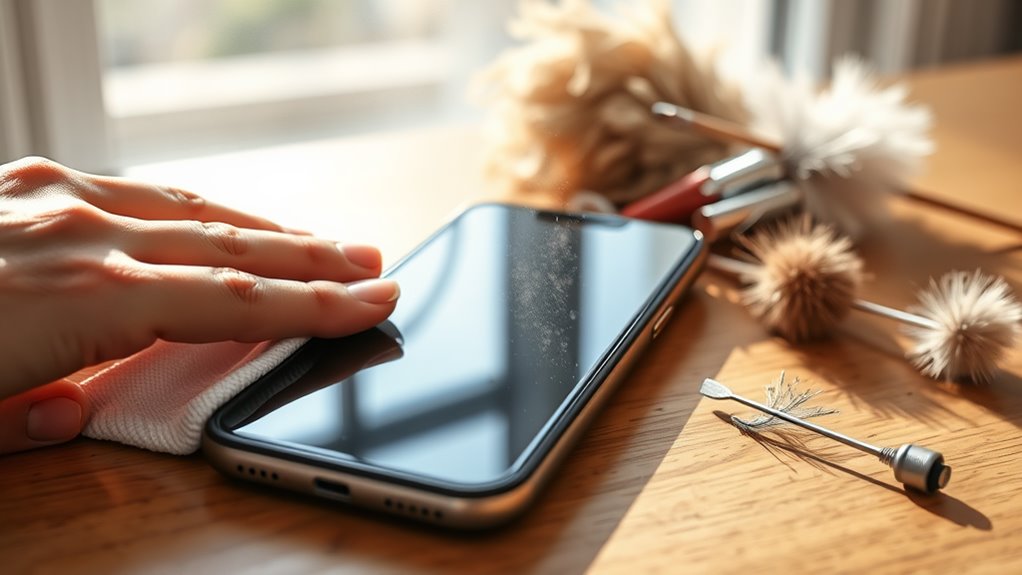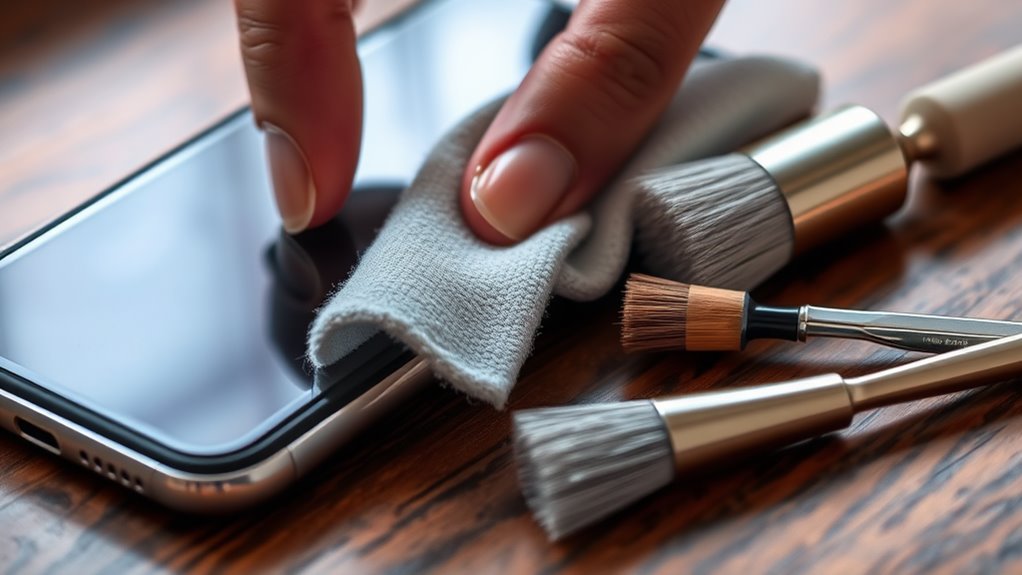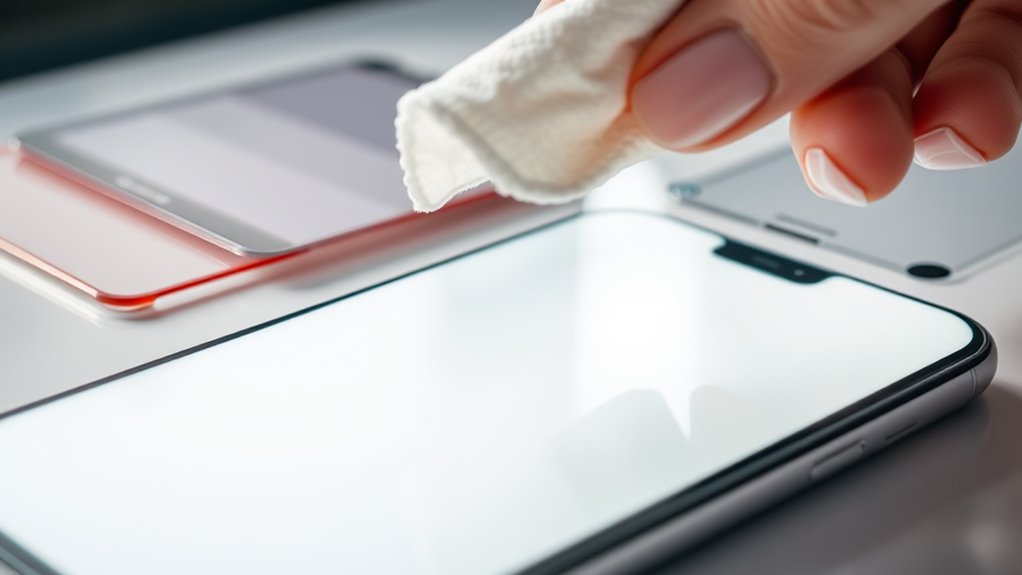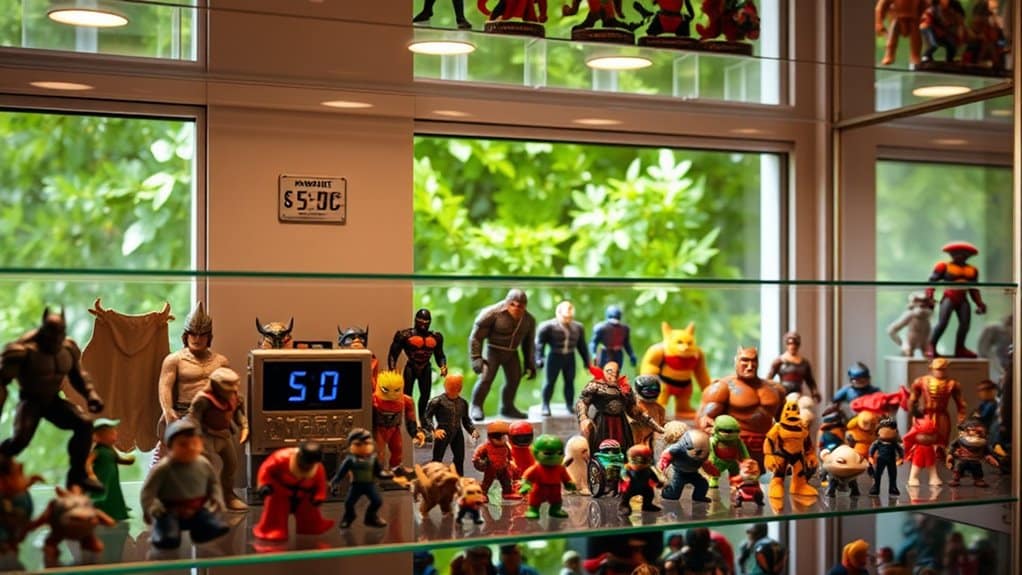To prevent scratches on display covers, choose materials like acrylic or tempered glass for durability. Apply protective films carefully, ensuring surfaces are clean. Use a microfiber cloth for dusting, and handle cases gently. Place them on stable surfaces, away from high-traffic areas. Implement barriers or edge guards for extra protection. With regular maintenance and smart placement, your display covers remain pristine. Discover more about maintaining display aesthetics and longevity.
Choosing the Right Display Case Material
When it comes to choosing the right display case material, it's important to take into account both protection and aesthetics. You want a material that not only looks great but also guards against scratches effectively. Acrylic is a popular choice because it's lightweight, clear, and offers good scratch resistance. However, it's vital to handle it with care to avoid any damage. Glass, while heavier, provides excellent clarity and superior scratch resistance, making it perfect for high-end displays. If you're displaying items in a high-traffic area, consider tempered glass for added durability. Polycarbonate is another option, known for its toughness and impact resistance, though it might be prone to scratching over time. Evaluate your needs carefully to select the best material.
Applying Protective Film or Coating
To protect your display covers from scratches, consider applying a protective film or coating. You'll find various types, such as those offering anti-glare or added durability, each serving different needs. When applying these films, make certain to follow the manufacturer's instructions carefully to avoid air bubbles and guarantee a smooth finish.
Types of Protective Films
Protective films offer a practical solution to keep your display covers scratch-free and looking brand new. You've got several types to choose from, each with its own benefits. Tempered glass protectors are highly durable, providing excellent protection against impacts and scratches. They're ideal if you want something robust. PET film protectors are lightweight and less expensive, offering basic scratch resistance. If you're after something with a matte finish, TPU films provide flexibility and self-healing properties, which is great for minor scratches. Nano liquid screen protectors create an invisible layer on your display. They're easy to apply and maintain, though they might not be as protective as other options. Consider your needs and preferences when selecting the right film for you.
Application Process Tips
Choosing the right protective film is just the beginning; applying it correctly guarantees you get the most out of your investment. First, make sure your display surface is spotless. Use a microfiber cloth to remove dust and fingerprints. Next, align the film carefully with the edges of your display. Start at one corner and gradually peel the backing as you press the film down. Use a credit card or squeegee to smooth out air bubbles, working from the center to the edges. If you mess up, don't worry—just lift the film gently and reapply. Finally, double-check for any remaining bubbles or dust particles. Patience and precision are key. Follow these steps, and you'll protect your device for the long haul.
Regular Dusting and Cleaning Techniques

To keep your display covers scratch-free, use gentle cleaning tools like microfiber cloths that won't leave marks. When removing dust, make sure you're lifting it away rather than pushing it around, which could cause scratches. By adopting these careful techniques, you'll maintain a pristine surface for longer.
Gentle Cleaning Tools
When it comes to keeping your display covers pristine, using the right gentle cleaning tools is crucial. The key is to choose materials that won't scratch or damage the surface. Start with a microfiber cloth. It's soft, non-abrasive, and effectively lifts dust and smudges without leaving scratches. Avoid using paper towels or rough fabrics, as they can create micro-abrasions over time.
Another valuable tool in your cleaning arsenal is a lens brush. It gently removes particles without applying pressure. Additionally, consider using a cleaning solution specifically designed for screens. Make sure it's alcohol and ammonia-free to avoid potential damage.
Regularly clean your tools, too, so they remain free from debris that could inadvertently scratch your display cover. Consistent care guarantees long-lasting clarity.
Proper Dust Removal
Maintaining a scratch-free display cover goes beyond just cleaning; it involves regular dust removal. Dust particles, though tiny, can scratch the surface over time. Start by using a microfiber cloth to gently sweep away dust daily. This type of cloth minimizes friction and avoids dragging particles across the cover. Don't wait for visible dust buildup—make it a habit to wipe down your display often.
Avoid using paper towels or rough fabrics as they can be abrasive. For stubborn dust, lightly dampen your microfiber cloth with water or a mild cleaning solution, ensuring it's not too wet. Avoid spraying liquids directly onto the display. Remember, consistent care and gentle techniques are your best allies in keeping your display cover pristine.
Proper Handling and Placement of Display Cases
While guaranteeing your display cases remain scratch-free, proper handling and strategic placement are key factors to evaluate. Always lift display cases with both hands to distribute weight evenly and avoid accidental slips. Avoid dragging cases across surfaces, which can lead to scratches. Instead, gently place them down after confirming the surface is clean and level.
Choose locations wisely. Keep cases away from high-traffic areas to minimize accidental bumps. Consider placing them on stable, non-slip surfaces, and avoid proximity to sharp or abrasive objects. Ascertain there's adequate space around each case to prevent collisions.
Also, be mindful of temperature and humidity, as extreme conditions can warp cases, making them more susceptible to damage. By following these guidelines, you can greatly reduce the risk of scratches.
Using Soft Cleaning Cloths and Tools

One essential step in keeping display covers scratch-free is using the right cleaning materials. Always choose soft, microfiber cloths as they're gentle on surfaces. These cloths effectively remove dust and fingerprints without scratching. Avoid using paper towels or rough fabrics, which can cause tiny scratches over time. When cleaning, gently wipe the surface in a circular motion to minimize friction.
It's important to pair your cloth with a cleaning solution specifically designed for screens. Many general household cleaners contain harsh chemicals that can damage the display. Instead, opt for screen-safe solutions or distilled water for a gentle clean. Regularly washing your cloths guarantees dirt particles don't accumulate and scratch the surface. By being mindful of your cleaning tools, you'll maintain your display covers in pristine condition.
Implementing Protective Barriers and Guards
Besides using the right cleaning materials, implementing protective barriers and guards can effectively prevent scratches on display covers. You should consider adding clear acrylic sheets or glass panels as physical barriers. These act as a shield between your display items and any potential contact that could cause scratches. You can also use edge guards to protect the corners of your display covers, which are particularly vulnerable to bumps and knocks. When choosing guards, go for materials that are transparent and durable, ensuring they don't obstruct the view of your items. Attaching soft pads to the base of your display stands can provide additional protection by absorbing impact. Remember, these barriers and guards not only protect but also help maintain the aesthetic appeal of your collection.
Ensuring Adequate Spacing Between Figurines
Proper spacing is essential for preventing scratches on your display covers and maintaining the condition of your figurines. When arranging your figurines, make sure there's enough room between each piece. This avoids accidental bumps that can lead to scratches. Use a ruler or measuring tape to achieve uniform spacing, making certain each figurine has its own designated area.
Consider the size and shape of each figurine. Larger pieces may need more space than smaller ones. Also, be mindful of any accessories or protruding parts that could touch other figurines. Rearrange as necessary to create a balanced display.
Investing in Anti-Scratch Cleaning Solutions
While spacing your figurines carefully is a great start, investing in anti-scratch cleaning solutions further protects your display covers. These solutions not only clean but also coat the surface, adding a protective layer against scratches. You'll find them easy to use and effective.
Here are three key features to take into account when choosing an anti-scratch cleaning solution:
- Non-abrasive Formula: Look for products specifically labeled as non-abrasive. They clean without damaging the surface.
- Protective Coating: Opt for solutions that promise a protective film. This extra layer helps repel dust and minor abrasions.
- Compatibility: Verify the solution is safe for the material of your display cover, whether it's glass, acrylic, or plastic.
Monitoring and Controlling Environmental Factors
To keep your display covers scratch-free, focus on controlling environmental factors like temperature and humidity. By maintaining a stable environment, you reduce the risk of warping or cracking, which can make surfaces more prone to scratches. Also, manage dust and debris by regularly cleaning the area to prevent abrasive particles from accumulating on the surface.
Temperature and Humidity Control
Maintaining the right temperature and humidity is essential for preventing scratches on display covers. When you control these environmental factors, you reduce the risk of materials expanding or contracting, which can cause surface damage. Here's how you can effectively manage temperature and humidity:
- Use a Hygrometer: Monitor humidity levels with a reliable hygrometer. Aim for a range between 30% and 50% to prevent condensation and material warping.
- Install Climate Control Systems: Invest in air conditioning or heating systems to maintain a stable temperature. Keep your space between 68°F and 72°F for ideal conditions.
- Use a Humidifier or Dehumidifier: Adjust humidity with these devices. A humidifier adds moisture, while a dehumidifier removes excess humidity, ensuring a balanced environment.
These steps help protect your displays effectively.
Dust and Debris Management
When it comes to keeping display covers scratch-free, controlling dust and debris is essential. You should regularly clean the surrounding area to minimize the particles that can settle on the surface. Use a microfiber cloth or a dusting tool to gently wipe the display cover, ensuring you don't press too hard and create scratches yourself. Keeping the environment clean is crucial, so make sure your workspace is free from clutter that can harbor dust.
Consider using an air purifier to reduce airborne particles, especially if you're working in a space prone to dust accumulation. Regularly check your air filters and replace them as needed to maintain efficiency. By actively managing dust and debris, you considerably reduce the risk of scratches on your display covers.
Scheduling Routine Maintenance and Inspection
Although display covers are designed to be durable, scheduling routine maintenance and inspection is crucial to prevent scratches and extend their lifespan. By setting up a regular schedule, you guarantee that potential issues are identified and addressed before they become severe. Here's how you can maintain your display covers effectively:
- Inspect Regularly: Check for any signs of wear or damage. Early detection can save you from costly repairs.
- Clean Properly: Use recommended cleaning solutions and soft cloths to remove dust and fingerprints without scratching the surface. Avoid harsh chemicals.
- Document Findings: Keep a log of inspections and any maintenance performed. This will help track the condition over time and inform future actions.
Frequently Asked Questions
Can UV Exposure Cause Scratches on Display Covers?
UV exposure won't directly cause scratches on display covers, but it can degrade the material over time, making it more susceptible to damage. So, you should use screen protectors to keep your device safe from potential harm.
Do Temperature Fluctuations Affect the Durability of Display Covers?
You're wondering if temperature fluctuations impact display cover durability. Yes, they do. Rapid changes can cause expansion and contraction, leading to stress and potential damage. So, keep your device in stable environments to maintain its longevity.
Are Certain Types of Lighting Harmful to Display Covers?
Certain types of lighting, especially direct sunlight or harsh fluorescent lights, can cause damage to display covers over time. You should use UV filters or anti-glare screens to reduce potential harm and extend your display's lifespan.
How Does Humidity Influence the Risk of Scratches on Display Covers?
You'll notice that high humidity can cause moisture buildup, making the display cover sticky. This increases the risk of dust and debris sticking, leading to scratches when you clean or use the display regularly.
Can Insects or Pests Contribute to Scratches on Display Covers?
Imagine a tiny army of insects marching across your screen, leaving behind trails of chaos. Yes, pests can contribute to scratches. Their sharp legs and abrasive bodies can create unwanted marks on display covers. Protect your devices!
At a Glance
To keep your display covers scratch-free, think of them like cherished treasures. Choose materials wisely and apply protective films as a shield. Regular cleaning and gentle handling prevent damage, just as soft cloths and proper tools do. Space your figurines like dancers on a stage, ensuring they don't touch. Anti-scratch solutions and routine inspections are your allies. By controlling the environment, you'll maintain their pristine condition and enjoy their beauty for years.





